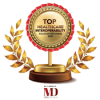The field of data analytics in medical technology is evolving and modulating in new and exciting ways, but the primary goals are generally the same. The point of analyzing raw data is to build upon the repository of information that you’ve developed so that you can draw meaningful conclusions. Data analytics is particularly important in the healthcare industry because the data allows you to validate your diagnostic inclinations, while simultaneously offering a way to track and act upon trends in disease, treatments and outcomes.

What Are 3 Ways Data Analytics Transforms Healthcare?
Of course, data analytics can be spliced and diced in a myriad of ways, but there are three easily identified ways that the healthcare industry is already feeling the positive influences of data analytics and use. These roads are also impacting the way most doctors and healthcare providers are managing their practices.
Facilitate Better Diagnostics
Patient records have long been a repository of essential data that was compartmentalized and generally unusable and inaccessible by other healthcare professionals. With the advancements in access to the repository of critical patient information via ChartSwap’s innovative health data exchange platform, healthcare professionals can improve not only their diagnostic abilities but also the accuracy and dosage of prescriptive treatments.
Beyond just improving the bottom line for practices, data analytics can allow healthcare professionals to dig into those diagnostic mysteries and solve puzzles. The real outcome is that patients benefit from (hopefully) quicker and more accurate diagnostics.
Address Preventable Illness
Internationally, the goal of many human rights and healthcare organizations is to treat and eliminate the more common preventable illnesses and diseases. While these efforts are sometimes hampered by external forces that are more difficult to manage, data analytics has been a force in transforming how we look at disease and how we treat it both in the US and around the world. Some of the most important ways of preventing illness are by looking at the risk factors for chronic diseases, based on population health data; but there’s also an essential next step in acting upon the data analytics that is so easily accessible by healthcare professionals. By addressing the prevalence of preventable illness and disease, hospitals begin to avoid the $1.9 billion in fees and fines levied against them because of readmission and preventable diagnostic issues.
First, Do No Harm
It’s the most basic exemplification of the Hippocratic Oath, and it’s a vow to avoid intentionally harming a patient. Data analytics has also played a huge, even transformational, role in making sure that doctors and healthcare professionals have the data they need to avoid mistakes, misinformation and statistically unreliable treatment protocols. Of course, malpractice is always a factor here too.
The data is all there, easily accessible in real-time, for review and comparison, but it also dramatically reduces the unnecessary harm by more than 40 percent. That includes treatments that don’t have the desired outcomes, as well as screenings and testing that is unnecessarily invasive and risky. A report by the Institute of Medicine estimated that 30 percent of healthcare spending ($750 billion) is unneeded.
Data analytics is transformative, and these examples are just the tip of the iceberg. As analytics continues to evolve and become inextricably tied into every aspect of medical technology, doctors and healthcare professionals will be able to offer a more holistic approach to improving patient health and wellness, based not only on the vast repository of data from across the US and around the world, but also drilled in on the specific diagnostic features and tendencies of every patient.
Increased access to data analytics also offers unprecedented advances in comprehensive and reliable approaches to treatment. With data analytics, each patient can drive their own healthcare experience via an ever-increasing focus on ways to uncover likely diagnostic patterns, and then the ability of healthcare professionals and patients to track the current status of each patient’s health. The future is fascinating and hopeful, but it also goes back to the, “First, do no harm.” Healthcare should and will continue to improve lives without harmful side effects. That’s the ultimate goal of data analytics and modern medical technology.
Learn How You Can Benefit From Using ChartSwap
Sources
Changing gears with eROI. Henry Ford Hospital switches to an electronic process for managing release-of-information requests without having to ask their CFO.
How Can Electronic Health Records Improve The Efficiency Of My Staff?
Medical Practice Efficiencies & Cost Savings
Electronic Health Records To Facilitate Clinical Research
Why The Promise Of Electronic Health Records Has Gone Unfulfilled
What It Means To Be A Secondary User Of Health Record Data






